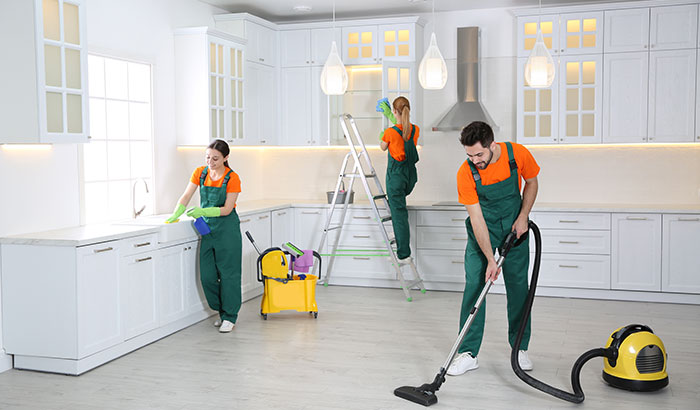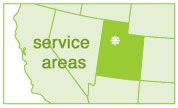Move-out cleaning is a standard part of moving from one residence to another. Just like you want your new home to be clean before moving in, it’s your responsibility to ensure your old home is clean for its next resident.
But what exactly is involved in move-out cleaning? And how long does a move-out cleaning take? We’re discussing that in today’s blog, so keep reading to learn more!
What to Clean Before Moving Out
There are six primary areas you should focus on during move-out cleaning, many of which overlap. They include your kitchen, bathroom, living areas, bedroom, closet and storage, and outside areas. This section breaks down the components of each room, so keep reading if you aren’t sure what to clean before moving out.
Kitchen
- Clean the inside and outside of appliances. First, you’ll want to unplug your fridge and remove all the shelves and drawers. Use warm, soapy water to clean the inside of the refrigerator, making sure to get rid of any stains or spills. Wipe the outside with a damp cloth, and dry it with a towel.
Next, tackle the stove and oven. Remove the racks, and soak them in warm water with dish soap. Use a cleaner for your stove and oven to eliminate grease or grime. Remember to clean the microwave, dishwasher, and other appliances.
- Wipe down cabinets and drawers. After removing everything, use a damp cloth and mild detergent to wipe down the inside and outside surfaces. Pay special attention to areas around handles and knobs, as these can get particularly dirty.
Use a mixture of water and white vinegar for tougher stains or buildup. Once you’ve finished wiping down the cabinets and drawers, give them a final wipe with a clean, dry cloth to ensure they’re completely dry.
- Scrub the sink and faucet. Over time, these areas can accumulate soap scum, food residue, and other buildup. Remove any dishes or debris from the sink. Then, use a scrub brush and mild detergent to clean the sink basin and get into all the corners and crevices.
Next, focus on the faucet and handles. Use a toothbrush or small scrub brush to clean around the base of the faucet and any hard-to-reach areas.
Finish by wiping everything down with a clean, damp cloth and drying it off with a towel. A clean sink and faucet will look better and help prevent the growth of bacteria and other germs.
- Sweep and mop floors. Sweep or vacuum the entire area to remove loose debris or dirt. Next, clean the floors with a mop and bucket filled with warm, soapy water. Make sure to wring out the mop thoroughly to avoid leaving excess water on the floors, as this can cause damage over time.
Pay extra attention to areas around appliances or cabinets where dirt and debris accumulate. Once you’ve finished mopping, give the floors time to dry completely before walking on them.
Bathroom
- Clean the toilet, bathtub, and shower. Use a toilet bowl cleaner and brush to remove any stains or buildup. Be sure to clean the inside and outside of the toilet bowl, the base, and the seat.
Next, move on to the bathtub and shower. Use a mild bathroom cleaner and scrub brush to remove soap scum or mildew. Pay extra attention to areas around the drain and faucet where buildup can occur. Rinse everything thoroughly with water and wipe down with a clean, dry cloth.
- Wipe down the sink and countertop. Use a mild all-purpose cleaner and a clean cloth to wipe down the surfaces. Pay extra attention to any areas with visible stains or spills.
Once you’ve finished wiping everything down, give it a final rinse with water and dry it off with a clean towel. This will not only remove dirt or grime but also help prevent the growth of bacteria and other germs.
- Scrub tiles and grout. Spray the tiles and grout with warm water and a mild all-purpose cleaner. Then, use a scrub brush or toothbrush to scrub the grout lines and tiles, paying extra attention to areas with visible stains or discoloration. Rinse everything thoroughly with water and use a clean towel to dry it off.
If tough stains don’t come out with a mild cleaner, you can try using a stronger or specialized grout cleaner. A clean and fresh-looking tile and grout will not only make your bathroom or kitchen look better but will also help prevent the growth of mold and mildew.
Living Areas
- Dust and wipe down all surfaces. Use a microfiber cloth or a duster to gently remove any dust or debris from the surface. Remember to pay attention to hard-to-reach areas, such as corners or crevices.
Once you’ve finished dusting, use a mild all-purpose cleaner and a clean cloth to wipe down the surfaces. Pay extra attention to any areas that are visibly dirty or have stains. If the surfaces are made of wood, follow the grain and avoid using too much water, as this can damage the wood.
Once you’ve finished wiping everything down, give it a final wipe with a dry cloth to remove any excess moisture.
- Vacuum carpets and upholstery. Use a vacuum with a beater brush attachment to thoroughly clean the carpets and upholstery. Pay extra attention to high-traffic areas and any visible stains or spots.
If there are any stubborn stains, you can use a specialized carpet or upholstery cleaner to treat them. Once you’ve finished vacuuming, empty the dustbin or replace the vacuum bag, and give the vacuum a quick wipe-down to remove any dust or debris.
- Clean windows and mirrors. Start by removing any curtains or blinds from the windows so that you can access the glass. Then, use a glass cleaner and a microfiber cloth to wipe down the windows and mirrors, paying extra attention to any spots or streaks.
If the windows or mirrors are filthy, you may need a specialized cleaner or a warm water and vinegar solution to remove any grime or buildup.
Be sure to wipe the edges and corners of the windows and mirrors, as these areas can often be overlooked. Once you’ve finished cleaning, replace any curtains or blinds, and enjoy the sparkling clean view.
- Sweep and mop hard floors. Use a broom or vacuum to sweep the floors, paying extra attention to any corners or edges.
Once you’ve finished sweeping, use a mop or a steam cleaner to clean the floors. Be sure to use a cleaner appropriate for your type of flooring, as some cleaners can damage certain materials.
If there are any stubborn stains or marks, you may need to use a specialized cleaner or a solution of warm water and vinegar to remove them. Once you’ve finished mopping, allow the floors to air dry, or use a dry mop to remove any excess moisture.
Bedroom
- Dust and wipe down all surfaces. Use a microfiber cloth or a duster to remove any dust or debris from the surfaces. Be sure to pay extra attention to often-overlooked areas, such as the tops of dressers, nightstands, and bookshelves.
Once you’ve finished dusting, use a gentle cleaning spray and a fresh cloth to wipe down the surfaces. Be sure to use a cleaner appropriate for the surface material, as some cleaners can cause damage or discoloration.
- Vacuum carpets and upholstery. After clearing the floor, use a vacuum cleaner with a filter to remove any loose dirt or debris from the carpets and upholstery. Be sure to pay extra attention to overlooked areas, such as under furniture or along baseboards.
If there are any stains or spots on the carpets or upholstery, you may need to use a specialized cleaner or solution to remove them. Once you’ve finished vacuuming, dispose of any debris in the vacuum cleaner and replace the filter if necessary.
Closets & Storage Areas
- Remove all items and dust shelves and hangers. Be sure to pay extra attention to any corners or crevices where dust can accumulate. If there are any stains or marks on the shelves, you may need to use a specialized cleaner to remove them.
- Sweep or vacuum floors. If you’re sweeping, use a broom and dustpan to collect the dirt and debris, starting at one end of the room and working toward the other. Be sure to sweep under furniture and in corners where dust and debris can accumulate.
If you’re vacuuming, use a vacuum cleaner with a filter and attachments to collect the dirt and debris. Be sure to vacuum under furniture, along baseboards, and in corners. If there are any stains or marks on the floors, you may need to use a specialized cleaner or solution to remove them.
Once you’ve finished sweeping or vacuuming, dispose of any debris and enjoy your floor’s fresh, clean look.
Outside Areas
- Sweep porches and patios. These outdoor areas can accumulate dirt, leaves, and debris over time, making them look unkempt and uninviting. Clear the floor, then use a broom or outdoor vacuum to sweep away any dirt, leaves, or debris. Be sure to sweep under any furniture or planters and in corners where debris may accumulate.
If there are any stains or marks on the porch or patio, you may need to use a specialized cleaner or solution to remove them.
- Clean outdoor furniture. Begin by removing any cushions or covers from the furniture and setting them aside. Use a soft-bristled brush or cloth to remove any loose dirt or debris from the furniture’s surface. If there are any stubborn stains or marks, you may need to use a specialized cleaner or solution to remove them.
Be sure to follow the manufacturer’s instructions for any cleaning products used, and test the solution on a small, inconspicuous area before applying it to the entire piece of furniture.
Once the furniture has been cleaned, rinse it thoroughly with water and allow it to dry completely before replacing any cushions or covers. Clean outdoor furniture looks better and can help increase your home’s curb appeal and value.
How Long Does a Move-Out Cleaning Take?
So, how long does a move-out cleaning take? Various factors affect how long it will take, including:
- The size of your home.
- How much cleaning is required?
- How many people are cleaning?
You can generally expect cleaning to take a few hours to a few days. A smaller home or apartment may only take a few hours to clean, while a larger home with multiple bedrooms, bathrooms, and common areas could take several hours or even a whole day.
If there is significant dirt, grime, or clutter to be removed, it may take longer to complete the cleaning. To better understand how long a move-out cleaning will take for your specific situation, it’s best to consult a professional cleaning service and discuss your needs and expectations.
Need a Move-Out Cleaning? Call Daisy Maids.
Now that you know what to clean before moving out of your home, you might decide it’s too much with all your other moving responsibilities. But you can have the best of both worlds by getting your deposit back and making sure your home is clean for the next residents.
Daisy Maids is here to help! We specialize in move-in-move-out services, where we clean everything you could need. We provide estimates before we begin a move-out cleaning and offer a discount for a first-time cleaning service. Call us at 801.335.5239 or email us at customercare@daisymaids.com to get started.





